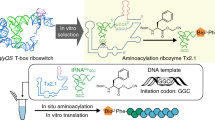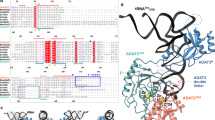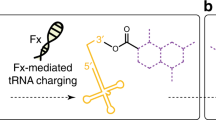Abstract
In modern organisms, protein enzymes are solely responsible for the aminoacylation of transfer RNA. However, the evolution of protein synthesis in the RNA world required RNAs capable of catalysing this reaction. Ribozymes that aminoacylate RNA by using activated amino acids have been discovered through selection in vitro1,2,3,4,5. Flexizyme is a 45-nucleotide ribozyme capable of charging tRNA in trans with various activated l-phenylalanine derivatives. In addition to a more than 105 rate enhancement and more than 104-fold discrimination against some non-cognate amino acids, this ribozyme achieves good regioselectivity: of all the hydroxyl groups of a tRNA, it exclusively aminoacylates the terminal 3′-OH5,6,7. Here we report the 2.8-Å resolution structure of flexizyme fused to a substrate RNA. Together with randomization of ribozyme core residues and reselection, this structure shows that very few nucleotides are needed for the aminoacylation of specific tRNAs. Although it primarily recognizes tRNA through base-pairing with the CCA terminus of the tRNA molecule, flexizyme makes numerous local interactions to position the acceptor end of tRNA precisely. A comparison of two crystallographically independent flexizyme conformations, only one of which appears capable of binding activated phenylalanine, suggests that this ribozyme may achieve enhanced specificity by coupling active-site folding to tRNA docking. Such a mechanism would be reminiscent of the mutually induced fit of tRNA and protein employed by some aminoacyl-tRNA synthetases8,9 to increase specificity.
This is a preview of subscription content, access via your institution
Access options
Subscribe to this journal
Receive 51 print issues and online access
$199.00 per year
only $3.90 per issue
Buy this article
- Purchase on Springer Link
- Instant access to full article PDF
Prices may be subject to local taxes which are calculated during checkout




Similar content being viewed by others
Accession codes
Primary accessions
Protein Data Bank
Data deposits
Atomic coordinates and structure factor amplitudes for aminoacyl-tRNA synthetase ribozyme–minihelix fusions refined against crystal II and crystal III data have been deposited with the Protein Data Bank with accession codes 3CUL and 3CUN, respectively.
References
Illangasekare, M., Sanchez, G., Nickles, T. & Yarus, M. Aminoacyl-RNA synthesis catalyzed by an RNA. Science 267, 643–647 (1995)
Illangasekare, M. & Yarus, M. A tiny RNA that catalyzes both aminoacyl-RNA and peptidyl-RNA synthesis. RNA 5, 1482–1489 (1999)
Illangasekare, M. & Yarus, M. Specific, rapid synthesis of Phe-RNA by RNA. Proc. Natl Acad. Sci. USA 96, 5470–5475 (1999)
Lee, N., Bessho, Y., Wei, K., Szostak, J. W. & Suga, H. Ribozyme-catalyzed tRNA aminoacylation. Nature Struct. Biol. 7, 28–33 (2000)
Saito, H., Kourouklis, D. & Suga, H. An in vitro evolved precursor tRNA with aminoacylation activity. EMBO J. 20, 1797–1806 (2001)
Saito, H. & Suga, H. A ribozyme exclusively aminoacylates the 3′-hydroxyl group of the tRNA terminal adenosine. J. Am. Chem. Soc. 123, 7178–7179 (2001)
Murakami, H., Saito, H. & Suga, H. A versatile tRNA aminoacylation catalyst based on RNA. Chem. Biol. 10, 655–662 (2003)
Cusack, S., Yaremchuk, A. & Tukalo, M. The crystal structure of the ternary complex of T. thermophilus seryl-tRNA synthetase with tRNASer and a seryl-adenylate analogue reveals a conformational switch in the active site. EMBO J. 15, 2834–2842 (1996)
Moulinier, L. et al. The structure of an AspRS-tRNAAsp complex reveals a tRNA-dependent control mechanism. EMBO J. 20, 5290–5301 (2001)
Schimmel, P., Giegé, R., Moras, D. & Yokoyama, S. An operational code for amino acids and possible relationship to genetic code. Proc. Natl Acad. Sci. USA 90, 8763–8768 (1993)
Ramaswamy, K., Saito, H., Murakami, H., Shiba, K. & Suga, H. Designer ribozymes: programming the tRNA specificity into flexizyme. J. Am. Chem. Soc. 126, 11454–11455 (2004)
Saito, H., Watanabe, K. & Suga, H. Concurrent molecular recognition of the amino acid and tRNA by a ribozyme. RNA 7, 1867–1878 (2001)
Selmer, M. et al. Structure of the 70S ribosome complexed with mRNA and tRNA. Science 313, 1935–1942 (2006)
Kirsebom, L. A. & Svard, S. G. Base pairing between Escherichia coli RNase P RNA and its substrate. EMBO J. 13, 4870–4876 (1994)
Eriani, G., Delarue, M., Poch, O., Gangloff, J. & Moras, D. Partition of tRNA synthetases into two classes based on mutually exclusive sets of sequence motifs. Nature 347, 203–206 (1990)
Rould, M. A., Perona, J. J., Söll, D. & Steitz, T. A. Structure of E. coli glutaminyl-tRNA synthetase complexed with tRNAGln at 2.8 Å resolution: implications for tRNA discrimination. Science 246, 1135–1142 (1989)
Ruff, M. et al. Class II aminoacyl transfer RNA synthetases: crystal structure of yeast aspartyl-tRNA synthetase complexed with tRNAAsp . Science 252, 1682–1689 (1991)
Nissen, P., Ippolito, J. A., Ban, N., Moore, P. B. & Steitz, T. A. RNA tertiary interactions in the large ribosomal subunit: the A-minor motif. Proc. Natl Acad. Sci. USA 98, 4899–4903 (2001)
Saenger, W. Principles of Nucleic Acid Structure (Springer, New York, 1984)
Burley, S. K. & Petsko, G. A. Weakly polar interactions in proteins. Adv. Protein Chem. 39, 125–192 (1988)
Murakami, H., Ohta, A., Ashiai, H. & Suga, H. A highly flexible tRNA acylation method for non-natural polypeptide synthesis. Nature Methods 3, 357–359 (2006)
Perona, J. J. & Hou, Y. M. Indirect readout of tRNA for aminoacylation. Biochemistry 46, 10419–10432 (2007)
Weiner, A. M. & Maizels, N. tRNA-like structures tag the 3′ ends of genomic RNA molecules for replication: implications for the origin of protein synthesis. Proc. Natl Acad. Sci. USA 84, 7383–7387 (1987)
Orgel, L. E. The origin of polynucleotide-directed protein synthesis. J. Mol. Evol. 29, 465–474 (1989)
Wong, J. T. Origin of genetically encoded protein synthesis: a model based on selection for RNA peptidation. Orig. Life Evol. Biosph. 21, 165–176 (1991)
Golden, B. L., Gooding, A. R., Podell, E. R. & Cech, T. R. A preorganized active site in the crystal structure of the Tetrahymena ribozyme. Science 282, 259–264 (1998)
Serganov, A. et al. Structural basis for Diels–Alder ribozyme catalyzed carbon–carbon bond formation. Nature Struct. Mol. Biol. 12, 218–224 (2005)
Klein, D. J. & Ferré-D’Amaré, A. R. Structural basis of glmS ribozyme activation by glucosamine-6-phosphate. Science 313, 1752–1756 (2006)
Giegé, R., Sissler, M. & Florentz, C. Universal rules and idiosyncratic features in tRNA identity. Nucleic Acids Res. 26, 5017–5035 (1998)
Saito, H. & Suga, H. Outersphere and innersphere coordinated metal ions in an aminoacyl-tRNA synthetase ribozyme. Nucleic Acids Res. 30, 5151–5159 (2002)
Ferré-D’Amaré, A. R. & Doudna, J. A. Crystallization and structure determination of a hepatitis delta virus ribozyme: use of the RNA-binding protein U1A as a crystallization module. J. Mol. Biol. 295, 541–556 (2000)
Ferré-D’Amaré, A. R. & Doudna, J. A. Use of cis- and trans-ribozymes to remove 5′ and 3′ heterogeneities from milligrams of in vitro transcribed RNA. Nucleic Acids Res. 24, 977–978 (1996)
Rupert, P. B. & Ferré-D’Amaré, A. R. Crystallization of the hairpin ribozyme: illustrative protocols. Methods Mol. Biol. 252, 303–311 (2004)
Otwinowski, Z. & Minor, W. Processing of X-ray diffraction data collected in oscillation mode. Methods Enzymol. 276, 307–326 (1997)
Brünger, A. T. et al. Crystallography and NMR system: a new software system for macromolecular structure determination. Acta Crystallogr. D 54, 905–921 (1998)
McCoy, A. J., Grosse-Kunstleve, R. W., Storoni, L. C. & Read, R. J. Likelihood-enhanced fast translation functions. Acta Crystallogr. D 61, 458–464 (2005)
Jones, T. A., Zou, J. Y., Cowan, S. W. & Kjeldgaard, M. Improved methods for building protein models in electron density maps and the location of errors in these models. Acta Crystallogr. A 47, 110–119 (1991)
DeLano, W. L. The PyMOL Molecular Graphics System (DeLano Scientific, San Carlos, CA, 2002)
Carson, M. Ribbons. Methods Enzymol. 277, 493–505 (1997)
Acknowledgements
We thank the staff at ALS beamline 5.0.2 and J. Bolduc for assistance with synchrotron and in-house X-ray data collection, respectively, and T. Edwards, T. Hamma, D. Klein, J. Pitt, J. Posakony, A. Roll-Mecak and B. Shen for discussions. A.R.F. is a Distinguished Young Scholar in Medical Research of the W. M. Keck Foundation. This work was supported by grants from research and development projects of the Industrial Science and Technology Program in the New Energy and Industrial Technology Development Organization (to H.S.) and the W. M. Keck Foundation (to A.R.F.).
Author information
Authors and Affiliations
Corresponding author
Supplementary information
Supplementary Information
The file contains Supplementary Figures 1-8 with Legends, Supplementary Table 1 and additional references. (PDF 1067 kb)
Rights and permissions
About this article
Cite this article
Xiao, H., Murakami, H., Suga, H. et al. Structural basis of specific tRNA aminoacylation by a small in vitro selected ribozyme. Nature 454, 358–361 (2008). https://doi.org/10.1038/nature07033
Received:
Accepted:
Published:
Issue Date:
DOI: https://doi.org/10.1038/nature07033
This article is cited by
-
Cell-free Biosynthesis of Peptidomimetics
Biotechnology and Bioprocess Engineering (2023)
-
Structure and mechanism of a methyltransferase ribozyme
Nature Chemical Biology (2022)
-
A new RNA performs old chemistry
Nature Chemical Biology (2022)
-
Single nucleotide translation without ribosomes
Nature Chemistry (2021)
-
An aminoacylation ribozyme evolved from a natural tRNA-sensing T-box riboswitch
Nature Chemical Biology (2020)
Comments
By submitting a comment you agree to abide by our Terms and Community Guidelines. If you find something abusive or that does not comply with our terms or guidelines please flag it as inappropriate.



